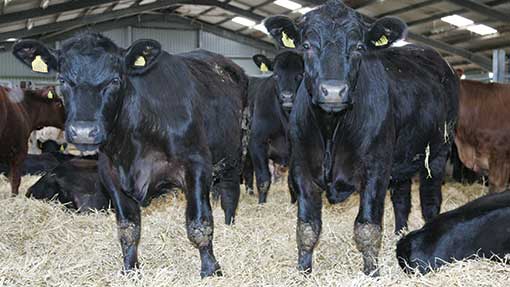Finish beef early to avoid fat class carcass penalties

Finishing beef cattle at lower liveweights can avoid fat class penalties on carcass value, according to research from Scotland’s Rural College (SRUC).
The EBLEX-funded research demonstrates how to avoid inefficiencies of too much fat in cattle by quantifying how quickly animals move through fat classes according to age, breed, sex and diet.
EBLEX beef and sheep scientist Liz Genever says farmers are driven to keep cattle for longer as they are paid for liveweight. However, it costs more and there may be limited added value as the weight gain is mainly fat.
The research shows there is a 1.5-2% fat trim increase as animals move from R4L and R4H. Moving from R4L to R4H for a medium-sized breed on an intensive feeding system takes 39 days for steers and 37 days for heifers.
“The ideal spec is E, U or R 3-4L, with some specialist markets accepting fat class 2. If they’re within the spec, get them gone,” she adds.
“Heavier animals are not always more profitable. The saleable meat yield can vary, with the proportion of fat in the body increasing as the animal matures,” explains Dr Genever.
Dr Genever says this latest research reinforces the importance of cattle handling around slaughter to maintain optimum carcass classification.
“Regular handling around slaughter date is vital. We now know it’s very easy for animals to go over and fall out of spec in terms of fat classes. Heifers in particular have a higher fat to muscle ratio and an earlier onset of the fattening phase,” says Dr Genever.
Other factors influencing fat class include breed, gender and diet.
- Breed influences levels of fat, speed and location of deposition. For example Aberdeen Angus crosses have 25% fat tissue, compared with 19% for Limousin crosses.
- Shorthorn heifers typically have 5.6kg (18%) more fat in the carcass than Shorthorn steers and 13.7kg (45%) more than bulls of the same breed when slaughtered.
- Levels of fat trim increase as proportion of cereals in diet rises.
- Cattle fed on a mixed grass and cereal diet have a lower proportion of subcutaneous fat in comparison to the same breeds fed a cereal-based diet alone.
Longer term it may be time to review your system, advises Dr Genever. “Look at your carcass returns and see if your system is working or if things such as rearing or finishing diets need tweaking,” she adds.
More online: See how one Aberdeenshire beef farmer is making a profit from continental beef
